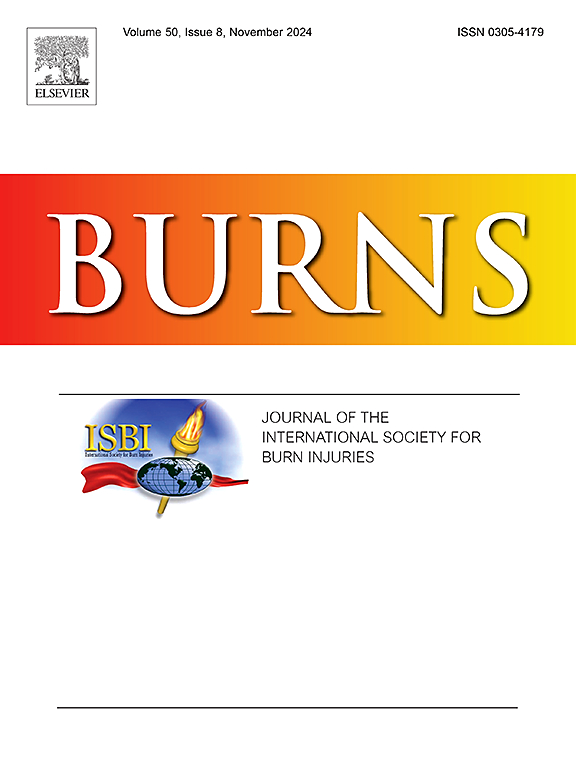A novel mouse model for studies of burn wound conversion using a top hat–shaped brass template
IF 3.2
3区 医学
Q2 CRITICAL CARE MEDICINE
引用次数: 0
Abstract
Introduction
The pathophysiology of burn wound conversion is not fully understood. Animal models are needed to elucidate the underlying mechanisms and develop treatments. Here, we established a new reproducible mouse model that simulates this process, thereby facilitating studies of burn wound conversion.
Materials and methods
After anesthesia and depilation, 75 mice were randomly assigned to 5-, 15-, and 25-s contact groups, and a top hat–shaped brass template was heated in boiling water and applied to the lateral abdomen. The wound area was calculated from photographs and the percentage of the surviving area was determined. Histological samples were collected 1–96 h after injury.
Results
A 15-s contact time produced the desired 50 %–75 % interspace necrosis at 96 h after injury. The 5-s contact group had a mostly preserved interspace, while the 25-s contact group exhibited near-complete necrosis. Histologically, significant differences between the 5- and 15-s contact groups were seen in cutaneous appendage denaturation and panniculus carnosus denaturation early after injury.
Conclusion
Exposing mice to the heated template for 15 s provides a reproducible model for studying burn wound conversion mechanisms and treatments, facilitating further elucidation of burn pathophysiology and evaluation of therapies to prevent burn wound conversion.
一种新的小鼠模型,用于研究用高顶帽形黄铜模板烧伤创面转化。
导读:烧伤创面转化的病理生理机制尚不完全清楚。需要动物模型来阐明潜在的机制和开发治疗方法。在这里,我们建立了一个新的可重复的小鼠模型来模拟这一过程,从而促进烧伤创面转化的研究。材料与方法:麻醉脱毛后,将75只小鼠随机分为5、15、25 s接触组,用沸水加热制取一顶帽形黄铜模板贴于外侧腹部。根据照片计算伤口面积,并确定存活面积的百分比。伤后1-96 h采集组织学标本。结果:损伤后96 h, 15 s接触时间产生所需的50 %-75 %间隙坏死。5-s接触组的间隙大部分保存完好,而25-s接触组则几乎完全坏死。在组织学上,接触5 s和接触15 s组在损伤后早期皮肤附着物变性和肉环变性方面存在显著差异。结论:将小鼠置于加热模板中15 s,为研究烧伤创面转化机制和治疗提供了一个可重复的模型,有助于进一步阐明烧伤病理生理学和评价预防烧伤创面转化的治疗方法。
本文章由计算机程序翻译,如有差异,请以英文原文为准。
求助全文
约1分钟内获得全文
求助全文
来源期刊

Burns
医学-皮肤病学
CiteScore
4.50
自引率
18.50%
发文量
304
审稿时长
72 days
期刊介绍:
Burns aims to foster the exchange of information among all engaged in preventing and treating the effects of burns. The journal focuses on clinical, scientific and social aspects of these injuries and covers the prevention of the injury, the epidemiology of such injuries and all aspects of treatment including development of new techniques and technologies and verification of existing ones. Regular features include clinical and scientific papers, state of the art reviews and descriptions of burn-care in practice.
Topics covered by Burns include: the effects of smoke on man and animals, their tissues and cells; the responses to and treatment of patients and animals with chemical injuries to the skin; the biological and clinical effects of cold injuries; surgical techniques which are, or may be relevant to the treatment of burned patients during the acute or reconstructive phase following injury; well controlled laboratory studies of the effectiveness of anti-microbial agents on infection and new materials on scarring and healing; inflammatory responses to injury, effectiveness of related agents and other compounds used to modify the physiological and cellular responses to the injury; experimental studies of burns and the outcome of burn wound healing; regenerative medicine concerning the skin.
 求助内容:
求助内容: 应助结果提醒方式:
应助结果提醒方式:


